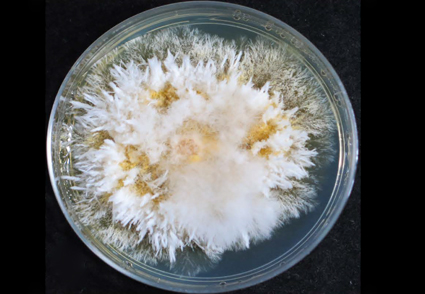Abstract
During an investigation of fungicolous fungi associated with mushrooms in China, four boleticolous fungi were collected from Sichuan Province. Based on the morphological features and multi-gene phylogenetic analyses this study introduces two new species, Hypomyces ampullaris, and H. sichuanensis. The new species are described and illustrated comprehensively and compared with their related fungi. Hypomyces ampullaris is similar to Sepedonium ampullosporum in forming candelabrum-like conidiophores and producing ampulliform conidia but differs from the latter in having shorter phialides and smaller ampulloconidia. Hypomyces sichuanensis is similar to H. chrysospermus, H. microspermus, and Sepedonium laevigatum in forming poorly developed verticills conidiophores and the shape and size of aleurioconidia. However, the asexual spores of H. sichuanensis averaged somewhat smaller than those of H. chrysospermus and S. laevigatum, and larger than that of H. microspermus. Additionally, H. ampullaris and H. sichuanensis distinct from their close relatives in no pigment discoloration of the PDA medium. These species introduced here, improve our understanding of the diversity of Hypomyces, especially of the boleticolous Hypomyces in China.
References
<p>Cunningham, C.W. (1997) Can three incongruence tests predict when data should be combined? <em>Molecular Biology and Evolution</em> 14 (7): 733<strong>–</strong>740. https://doi.org/10.1093/oxfordjournals.molbev.a025813</p>
<p>Damon, S.C. (1952) Two noteworthy species of <em>Sepedonium</em>. <em>Mycologia</em> 44 (1): 86<strong>–</strong>96. https://doi.org/10.1080/00275514.1952.12024172</p>
<p>Dou, K., Lu, Z.X., Wu, Q., Ni, M., Yu, C.J., Wang, M., Li, Y. Q., Wang, X.H., Xie, H., Chen, J. & Zhang, C.H. (2020) MIST: A multiloci identification system for <em>Trichoderma</em>. <em>Applied and Environmental Microbiology</em> 86 (18): e01532-20 https://doi.org/10.1128/AEM.01532-20</p>
<p>Hyde, K.D., Norphanphoun, C., Maharachchikumbura, S.S.N., Bhat, D.J., Jones, E.B.G., Bundhun, D., Chen, Y.J., Bao, D.F., Boonmee, S., Calabon, M.S., Chaiwan, N., Chethana, K.W.T., Dai, D.Q., Dayarathne, M.C., Devadatha, B., Dissanayake, A.J., Dissanayake, L.S., Doilom, M., Dong, W., Fan, X.L., Goonasekara, I.D., Hongsanan, S., Huang, S.K., Jayawardena, R.S., Jeewon, R., Karunarathna, A., Konta, S., Kumar, V., Lin, C.G., Liu, J.K., Liu, N.G., Luangsaard, J., Lumyong, S., Luo, Z.L., Marasinghe, D.S., McKenzie, E.H.C., Niego, A.G.T., Niranjan, M., Perera, R.H., Phukhamsakda, C., Rathnayaka, A.R., Samarakoon, M.C., Samarakoon, S.M.B.C., Sarma, V.V., Senanayake, I.C., Shang, Q.J., Stadler, M., Tibpromma, S., Wanasinghe, D.N., Wei, D.P., Wijayawardene, N.N., Xiao, Y.P., Yang, J., Zeng, X.Y., Zhang, S.N. & Xiang, M.M. (2020) Refined families of Sordariomycetes. <em>Mycosphere</em> 11 (1): 305<strong>–</strong>1059. https://doi.org/10.5943/mycosphere/11/1/7</p>
<p>Katoh, K. & Standley, D.M. (2013) MAFFT Multiple sequence alignment software Version 7: Improvements in Performance and Usability. <em>Molecular Biology and Evolution</em> 30 (4): 772<strong>–</strong>780. https://doi.org/10.1093/molbev/mst010</p>
<p>Nylander, J.A.A. (2004) MrModeltest v2. Program distributed by the author. Available from: https://github.com/nylander/MrModeltest2 (accessed 19 August 2021)</p>
<p>Poldmaa, K. (2000) Generic delimitation of the fungicolous Hypocreaceae. <em>Studies in Mycology</em> 45: 83<strong>–</strong>94.</p>
<p>Poldmaa, K. (2011) Tropical species of <em>Cladobotryum</em> and <em>Hypomyces</em> producing red pigments. <em>Studies in Mycology</em> 68: 1<strong>–</strong>34. https://doi.org/10.3114/sim.2011.68.01</p>
<p>Poldmaa, K. & Samuels, G.J. (1999) Aphyllophoricolous species of <em>Hypomyces</em> with KOH negative perithecia. <em>Mycologia</em> 91 (1): 177<strong>–</strong>199. https://doi.org/10.1080/00275514.1999.12061007</p>
<p>Poldmaa, K. & Samuels, G.J. (2004) Fungicolous hypocreaceae (Ascomycota: Hypocreales) from Khao Yai National Park, Thailand. <em>Sydowia</em> 56 (1): 79<strong>–</strong>130.</p>
<p>Rehner, S.A. & Samuels G.J. (1994) Taxonomy and phylogeny of <em>gliocladium</em> analyzed from nuclear large subunit sibosomal DNA sequences. <em>Mycological Research </em>98: 625<strong>–</strong>634. https://doi.org/10.1016/S0953-7562(09)80409-7</p>
<p>Rogerson, C.T. & Samuels, G.J. (1985) Species of <em>Hypomyces</em> and <em>Nectria</em> occurring on Discomycetes. <em>Mycologia</em> 77 (5): 763<strong>–</strong>783. https://doi.org/10.1080/00275514.1985.12025164</p>
<p>Rogerson, C.T. & Samuels, G.J. (1989) Boleticolous species of <em>Hypomyces</em>. <em>Mycologia</em> 81 (3): 413<strong>–</strong>432. https://doi.org/10.1080/00275514.1989.12025764</p>
<p>Rogerson, C.T. & Samuels, G.J. (1993) Polyporicolous Species of <em>Hypomyces</em>. Mycologia 85 (2): 231<strong>– </strong>272. https://doi.org/10.1080/00275514.1992.12026272</p>
<p>Rogerson, C.T. & Samuels, G.J. (1994) Agaricicolous species of <em>Hypomyces</em>. <em>Mycologia</em> 86 (6): 839<strong>–</strong>866. https://doi.org/10.1080/00275514.1994.12026489</p>
<p>Ronquist, F., Teslenko, M., van der Mark, P., Ayres, D.L., Darling, A., Hohna, S., Larget, B., Liu, L., Suchard, M.A. & Huelsenbeck, J.P. (2012) MrBayes 3.2: efficient bayesian phylogenetic inference and model choice across a large model space. <em>Systematic Biology</em> 61 (3): 539<strong>–</strong>542. https://doi.org/10.1093/sysbio/sys029</p>
<p>Rossman, A.Y., Seifert, K.A., Samuels, G.J., Minnis, A.M., Schroers, H.J., Lombard, L., Crous, P.W., Poldmaa, K., Cannon, P.F., Summerbell, R.C., Geiser, D.M., Zhuang, W.Y., Hirooka, Y., Herrera, C., Salgado<strong>-</strong>Salazar C. & Chaverri P. (2013) Genera in Bionectriaceae, Hypocreaceae, and Nectriaceae (Hypocreales) proposed for acceptance or rejection. <em>IMA Fungus </em>4 (1): 41<strong>–</strong>51. https://doi.org/10.5598/imafungus.2013.04.01.05</p>
<p>Sahr, T., Ammer, H., Besl H. & Fischer M. (1999) Infrageneric classification of the boleticolous genus <em>Sepedonium</em>: species delimitation and phylogenetic relationships. <em>Mycologia</em> 91 (6): 935<strong>–</strong>943. https://doi.org/10.1080/00275514.1999.12061104</p>
<p>Stamatakis, A. (2006) RAxML<strong>–</strong>VI<strong>–</strong>HPC: Maximum likelihood based phylogenetic analyses with thousands of taxa and mixed models. <em>Bioinformatics</em> 22 (21): 2688<strong>–</strong>2690. https://doi.org/10.1093/bioinformatics/btl446</p>
<p>Sun, J.Z., Liu, X.Z., Jeewon, R., Li, Y.L., Lin, C.G., Tian, Q., Zhao, Q., Xiao, X.P., Hyde, K.D. & Nilthong S. (2019a) Fifteen fungicolous Ascomycetes on edible and medicinal mushrooms in China and Thailand. <em>Asian Journal of Mycology</em> 2 (2): 129–169. https://doi.org/10.5943/ajom/2/1/7</p>
<p>Sun, J.Z., Liu, X.Z., McKenzie, E.H.C., Jeewon, R., Liu, J.K., Zhang, X.L., Zhao, Q. & Hyde K.D. (2019b) Fungicolous fungi: terminology, diversity, distribution, evolution, and species checklist. <em>Fungal Diversity </em>95 (1): 337<strong>–</strong>430. https://doi.org/10.1007/s13225-019-00424-7.</p>
<p>Tamm, H. &Poldmaa, K. (2013) Diversity, host associations, and phylogeography of temperate aurofusarin producing <em>Hypomyces</em>/<em>Cladobotryum</em> including causal agents of cobweb disease of cultivated mushrooms. <em>Fungal Biology</em> 117 (5): 348<strong>–</strong>367. https://doi.org/10.1016/j.funbio.2013.03.005</p>
<p>Valdez, G.U. & Douhan, G.W. (2012) Geographic structure of a bolete infecting cryptic species within the <em>Hypomyces microspermus </em>species complex in California. <em>Mycologia</em> 104 (1): 14<strong>–</strong>21. https://doi.org/10.3852/09-272</p>
<p>Wijayawardene, N.N., Hyde, K.D., Tibpromma, S., Wanasinghe, D.N., Thambugala, K.M., Tian, Q., Wang, Y. & Fu, L. (2017) Towards incorporating asexual fungi in a natural classification: checklist and notes 2012<strong>-</strong>2016. <em>Mycosphere</em> 8 (9): 1457<strong>–</strong>1555. https://doi.org/10.5943/mycosphere/8/9/10</p>
<p>Zare, R. & Gams, W. (2016) More white <em>verticillium</em><strong>-</strong>like anamorphs with erect conidiophores. <em>Mycological Progress</em> 15: 993<strong>–</strong>1030. https://doi.org/10.1007/s11557-016-1214-8</p>
<p>Zeng, Z.Q. & Zhuang, W.Y. (2015) Current understanding of the genus <em>Hypomyces</em> (Hypocreales). <em>Mycosystema</em> 34: 809<strong>–</strong>816. https://doi.org/10.13346/j.mycosystema.140116</p>
<p>Zeng, Z.Q. & Zhuang, W.Y. (2016) Three new species and two new Chinese records of <em>Hypomyces</em> (Hypocreales). <em>Mycosystema</em> 35: 1048<strong>–</strong>1055. https://doi.org/10.13346/j.mycosystema.160105</p>
<p>Zeng, Z.Q. & Zhuang, W.Y. (2019) Two New Species and a new chinese record of hypocreaceae as evidenced by morphological and molecular data. <em>Mycobiology</em> 47 (3): 280<strong>–</strong>291. https://doi.org/10.1080/12298093.2019.1641062 </p>
<p>Zhang, J.J., Kapli, P., Pavlidis, P. & Stamatakis, A.A (2013) General species delimitation method with applications to phylogenetic placements. <em>Bioinformatics</em> 29: 2869<strong>–</strong>2876. https://doi.org/10.1093/bioinformatics/btt499</p>


